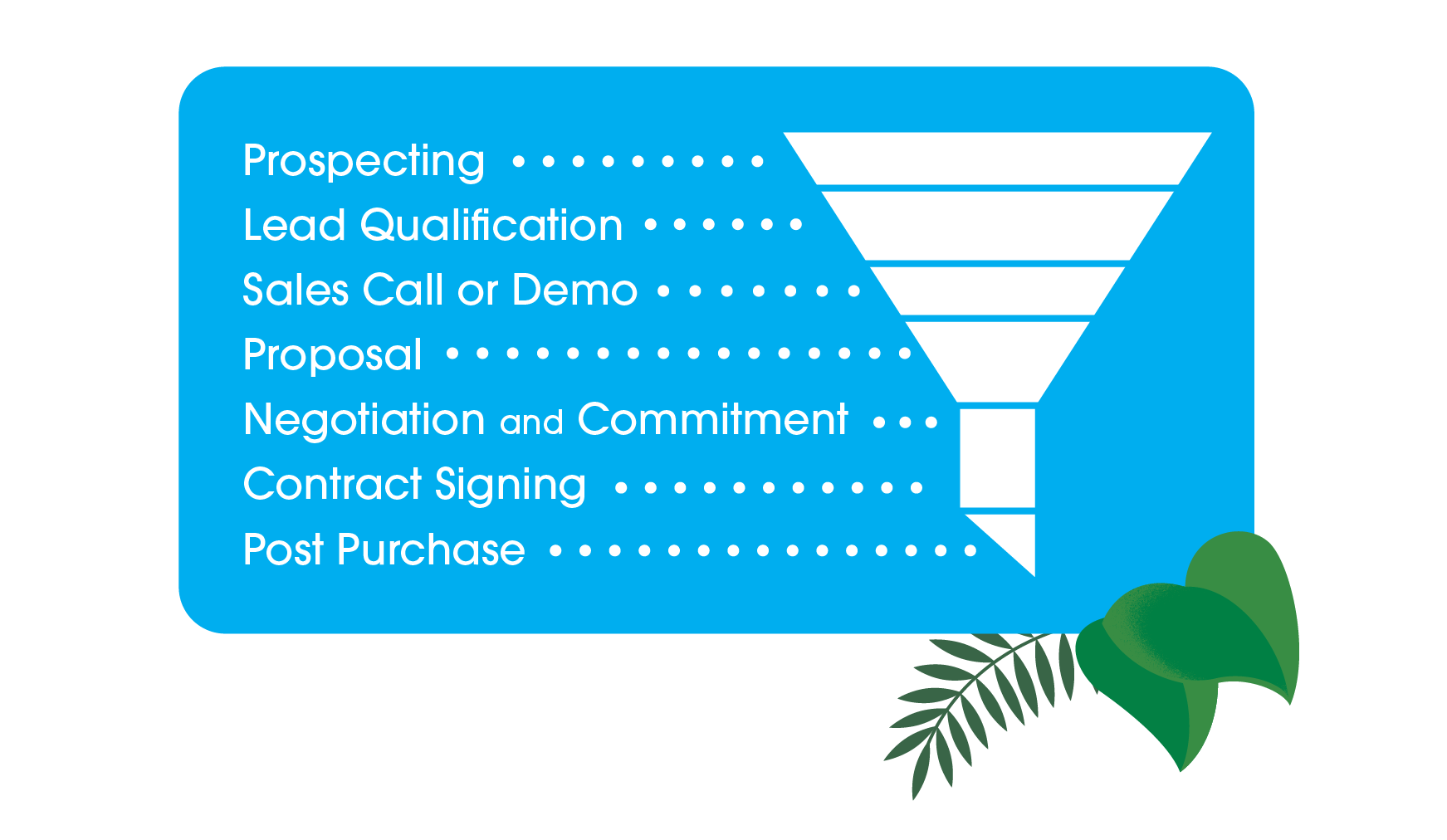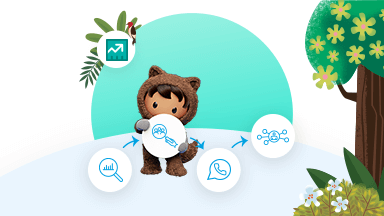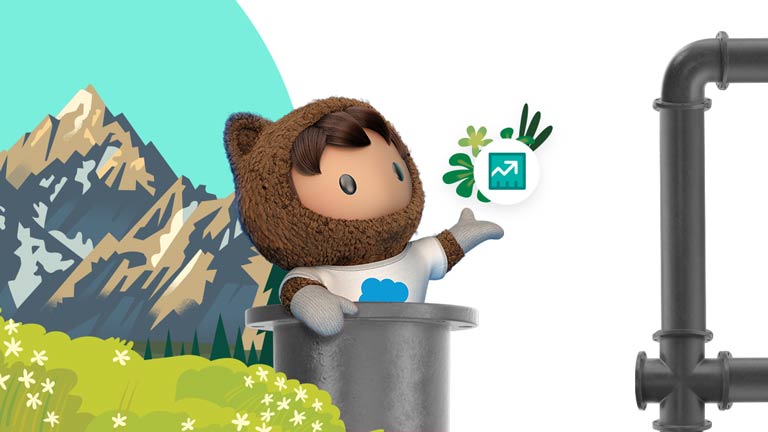How to Get Your Sales Pipeline to Flow And Grow
Managing your pipeline lets you catch tiny problems before they become big.
When people think of a sale, they often think of the close of the sale. But to fully understand selling, you need to look at the entire effort from start to finish with a bird’s eye view. How does a prospect progress through each stage until finally becoming a customer? That’s what a sales pipeline allows you to analyze.
Managing a sales pipeline, however, can be difficult. A study from Harvard Business Review found that 61% of executives think their sales managers are not properly trained in pipeline management. This can spell lost revenue. That’s why we created this resource — a starting point for any manager who needs to fully understand their reps’ pipelines.
What we’ll cover:
What is a sales pipeline?
A sales pipeline is a visual representation of where all of your prospects are in the sales process. This allows you to gauge likely revenue and determine the health of your business. It provides a snapshot of the health of your business. After all, you can’t manage what you don’t measure.
Imagine a pipeline as a free-flowing river. If there are problems upstream, there will eventually be problems downstream. Pipeline management allows you to catch tiny problems before they become big problems that impact revenue. With it, you can estimate how much your reps might close in a given week, month, or quarter.
A sales pipeline is not to be confused with a sales forecast. Though they draw from similar pools of data, a sales pipeline focuses on the present moment and what reps should be doing right now to close deals while a sales forecast estimates how much revenue a company can hope to bring in if those opportunities are indeed won.
What are the stages of a sales pipeline?

Don’t spend precious time and resources on a deal that never closes. Instead, focus on qualifying, or filtering out, your leads by creating an ideal customer profile, or buyer persona, that outlines the characteristics of the customers you’d like to bring in. Think about ideal industry, company size, location, pain points. This helps you decide whether a prospect is a good fit for your product. To move those leads deeper into the pipeline, consider offering an e-book, white paper, webinar, case study, or other type of free resource to determine if the prospect is interested in learning more about your solution. It’s also helpful to conduct a preliminary discovery call to get to know the prospect’s needs before you launch to the next step of a sales call.
“It's easy to be interested in a new feature or functionality, but then how do you get a prospect to prioritize and fund it?” said Hassan Abdalah, Account Director at Salesforce. “That's the tricky part.”
When you close a deal, you might think that it’s all over, but the customer experience has just begun. The buyer will expect attentive service during implementation and regular monitoring of the account’s progress. At the right times, you can cross-sell existing customers on new services and upsell them on premium solutions. Overall, be sure to treat your new customers well — referrals and future sales depend on it.
“You need to take ownership of that account because if you aren’t doing the right thing, if you aren’t following up, it’s up for grabs for someone else to take over,” said Galem Girmay, Sales Executive at GoContractor. “You want to protect what you’ve worked so hard for and make sure you’re always moving the conversation forward.”
“You need to take ownership of that account because if you aren’t following up, it’s up for grabs for someone else to take over. Make sure you’re always moving the conversation forward.”
“You need to take ownership of that account because if you aren’t following up, it’s up for grabs for someone else to take over. Make sure you’re always moving the conversation forward.”
How do you build a healthy sales pipeline?
In order for a pipeline to be considered healthy, it must flow. Prospects must move from one stage to the next in a determined time frame or be filtered out from the pipeline. Reps can track this flow in a CRM; regular pipeline reviews ensure you have consistent and reliable data about each opportunity. Reps can build a healthy pipeline by consistently bringing in fresh leads, qualifying those leads, nurturing leads to generate interest in your products, and, ultimately, closing sales.
“You want to make sure your goals as a sales team are reflected in your CRM, so that means having accurate data and updating your pipeline consistently as a prospect progresses from one stage to the next stage,” said Girmay.
The most important parts of building a pipeline include:
We touched on this earlier, but you find out if someone is a good fit for your product by qualifying the lead. The sales rep’s job is to then qualify those leads, meaning to figure out which ones are worth pursuing further. Each company will have different criteria for what counts as a good lead, with many companies even using a lead scoring system to prioritize leads based on how likely they are to purchase. For example, at Salesforce, our lead scoring system is powered by artificial intelligence to automatically prioritize leads based on CRM data.
Common questions you should ask when qualifying leads:
- Does this lead have a need for our solution?
- Do they have a budget for our solution?
- Is this lead in a decision-making position?
These questions are important as you don’t want stagnant leads clogging up your pipeline and throwing off your sales forecast.
“If you’re going to take meetings and allocate resources, make sure that you’re doing it with the right person, at the right time, and in the right area,” said Abdalah. “Because you don’t get those hours back, and your pipeline management won’t be as successful as it could be.”
Nurturing leads is developing and reinforcing a relationship by providing powerful insights that build trust in your solution. When it comes to nurturing, personalization and communication is the name of the game.
There are multiple ways to accomplish this, but a common one is email nurturing. It’s cost-effective and easy to automate with email marketing tools like Pardot. You can send leads relevant content, whether it’s blogs, videos, white papers, or e-books, and email marketing tools allow you to track how long a prospect is engaging with the material.
Other forms of nurturing can include direct mail, follow-up calls, or social media marketing. No matter how you do it, it’s important to keep the water warm with consistent follow-up and outreach since prospects typically won’t make a purchase during their first interaction with you.
Guiding prospects down the pipeline until they’ve become customers is known as conversion For each interaction you have with a prospect, be thinking of next steps. Focus and persistence are key when it comes to moving the conversation forward. Follow up, ask for feedback, and make use of a CRM so you can supervise prospects at each stage. If you’re in a position to do so, you can also offer discounts and incentives to give prospects a nudge.
Much of what happens at the end is decided by what you do at the beginning. If you’ve laid successful groundwork in qualifying and nurturing leads, this third step should flow naturally.
“If you’re going to take meetings with prospects and allocate resources, make sure that you’re doing it with the right person. Because you don’t get those hours back.”
“If you’re going to take meetings with prospects and allocate resources, make sure that you’re doing it with the right person. Because you don’t get those hours back.”
How do you evaluate a sales pipeline?
Now that you know how to make a healthy pipeline, how do you check to see if you’re doing it right? A good pipeline will have high sales velocity, a short sales cycle length, and a high conversion rate. How can you get a handle on these metrics? Well, keep reading because data points like these can paint a clear picture of where your pipeline is at.
A pipeline needs accurate data on prospects in order to be meaningful. This data can change minute to minute, which is why it demands constant monitoring. By tossing dirty data and adding updates whenever a new lead comes in or a prospect progresses to another stage, you’ll keep your pipeline well-oiled. At Salesforce, we use dashboards in Sales Cloud to visualize the pipeline and see which stage deals are in.

The problem, however, is that too many reps lean on anecdotes to determine the status of leads in the pipeline. “You have to stay grounded in data,” said Marcus Jewell, Chief Sales Officer at Juniper Networks, a network software company.
“We call it ‘anecdata’ when you come up with an anecdote and then try to justify it with confirmation bias. If the data's not clear, just say it's not clear. That's really how you de-risk and run good pipeline management.”
To keep your data clean and deals moving forward, you can set up trackable metrics and prospect details in your CRM and review them regularly. Each sales executive should customize pipeline metrics to meet their own aims, but here are a few of the basics that are usually included. Monitoring these numbers will tell you a lot about the state of your pipeline and help you catch potential problems early.
- Lead source: How did prospects find out about your product? Was it through an email campaign, a print promotion, digital marketing, and so on? Once you start paying attention to these sources, you might discover that some have a higher conversion rate than others. A referral might be more likely to buy than someone who stumbled across an online ad, for example.
- Industry: Buyers from a wide range of industries might be interested in your product, but is it a bit more popular in certain industries? Tracking this metric will help suss that out.
- Deal size: The budget of every prospect will be different. Some might be ready to drop six figures, while others won’t be able to afford your product at all. Keep this in mind when you're personalizing and prioritizing pitches.
- Decision makers: Do you have a direct line to the folks who will ultimately call the shots? Are you talking to the VP of sales or the VP of sales operations? If not, how can you connect with the decision maker?
- Conversion rate: Not every qualified lead turns into a customer. To accurately forecast, you need to know what percentage of opportunities end up progressing from stage to stage. If you’re trying to close 500 deals by the end of the quarter, and your conversion rate is 10%, that means you need to have 5,000 opportunities in your pipeline to meet that goal.
- Sales velocity: How much revenue does your team generate each day? Sales velocity helps you measure this by examining the speed at which a deal moves through your pipeline. A low velocity indicates pipeline bottlenecks. It also indicates whether you should reevaluate that prospect — either spending more energy on moving them along or cutting them altogether.
- Sales pipeline value: Tally up the dollar value of every deal in your pipeline. This number helps you determine the return on investment of your team’s efforts.
- Sales cycle length: How much time passes between a rep qualifying a lead and then closing that deal? This allows you to estimate how many opportunities might close in a given time period. It's also a good measuring stick for the progress of a deal, if the rep knows the average sales cycle length.
“Get to know what the life of your rep is like in terms of managing the process. Then make sure that process is as easy as it possibly can be.”
“Get to know what the life of your rep is like in terms of managing the process. Then make sure that process is as easy as it possibly can be.”
How do you work with reps to improve the sales pipeline?
Your CRM should be your best friend when it comes to measuring and managing your sales pipeline, but don’t underestimate the importance of frequent communication with your reps. While maintaining clean data in your CRM is critical to a healthy sales pipeline, pipeline reviews are just as important.
Regular pipeline reviews, when managers and reps discuss the status of pending deals one-on-one, are usually a source of dread. But sales teams should instead see reviews as an opportunity to realign goals (if necessary) and get additional coaching. When properly done, pipeline meetings can accomplish several things:
- Create a system of accountability for both sales reps and sales managers
- Establish action items and deal priorities with a specific timeline
- Confirm the exit criteria for every pipeline stage
Most importantly, managers have to practice empathy and patience in order to build trust with reps. This allows reps to better learn from mistakes, improves morale, and ultimately boosts productivity.
“You need to remember what it was like to be a rep. It amazes me how many chief revenue officers or chief sales officers wouldn't know what to do if you put them in front of the [CRM] screen,” Jewell said.
He added: “Get to know what the life of your rep is like in terms of managing the process. Then make sure that process is as easy as it possibly can be.”
What's next?
More Resources

State of Sales

See How Sales Cloud Makes Selling Easy









